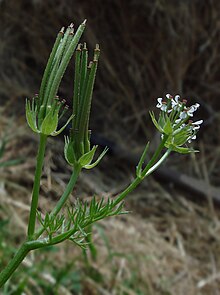Shepherd's-needle
| Scandix pecten-veneris | |
|---|---|
 |
|
| fruits and flowers | |
| Scientific classification | |
| Kingdom: | Plantae |
| (unranked): | Angiosperms |
| (unranked): | Eudicots |
| (unranked): | Asterids |
| Order: | Apiales |
| Family: | Apiaceae |
| Genus: | Scandix |
| Species: | S. pecten-veneris |
| Binomial name | |
|
Scandix pecten-veneris L. |
|
Scandix pecten-veneris (shepherd's-needle, Venus' comb, Venus's needle) is a species of edible plant belonging to the parsley family. It is native to Eurasia and it is known widely elsewhere as an introduced species and sometimes a weed. It is named for its long fruit, which has a thickened body up to 1.5 centimeters long and a beak which can measure up to 7 centimeters long and is lined with comblike bristles.
(Relating to subspecies pecten-veneris - the only subspecies occurring in the U.K.) Sparsely hairy annual. Stems to 50 cm, becoming hollow with age. Leaves bi- to tri-pinnate with lobes reaching around 10mm, narrow and entire to pinnatifid, petiole broadened at base and having scarious, usually ciliate margin. Umbels with 1-3 stout glabrous to sparsely hairy rays 0.5–4 cm in length; peduncle very short or absent; terminal umbel bearing hermaphrodite flowers and lateral umbels bearing variable proportions of male and hermaphrodite flowers. Bracts usually absent; bracteoles usually 5 in number, longer than pedicels, simple or irregularly (often deeply) divided. Flowers white; sepals small; outer petals not radiating; styles with enlarged base, forming stylopodium. Fruit 30-70mm, more or less cylindrical, slightly compressed laterally, with strongly dorsally flattened beak 3-4 times as long as and plainly distinct from seed-bearing portion, constricted at commissure; mericarps ribbed and scabrid with forward-pointing bristles on margins; carpophore present; vittae solitary and conspicuous; pedicels almost as thick as rays, glabrous at apex; styles 2-4 times as long as stylopodium, erect; stigma tapering. Cotyledons tapered gradually at base, without distinct petiole. Flowering time: May to June.
Chromosome number of Scandix pecten-veneris and infraspecific taxa 2n = 16, 26.
Scandix is in origin a Latin word for chervil used by Pliny the Elder, who was also the first to record the descriptive name pecten Veneris signifying 'Venus's comb'.
When the long, erect fruits develop among the legs of the wheat, Shepherd's Needle looks so peculiar that a farm population could not help noticing it and naming it.
Scandix pecten-veneris has a wealth of evocative common names in English - most of them needle-related, in reference to the distinctive fruit, which, when mature, make it unlikely to be confused with any other native umbellifer. The English folk imagination has made of the plant the 'needle' of the following : Adam, the beggar, the clock, the crow, the Devil, the Old wife/Old woman/Witch, Puck, the shepherd, and (more prosaically) the tailor. Of these, the tailor is (self-evidently) a user of needles in his work; Adam, the beggar, the crow and the shepherd convey rustic simplicity; the clock draws a parallel with clock hands and 'needles', and the Devil, the Witch and Puck play on the idea of the (malignly) supernatural and uncanny. English 'comb' names for the plant are less plentiful, one, of the two recorded, invoking (once again) the shepherd and the other relating to the lady i.e. 'Our Lady' - one of the titles of the Virgin Mary. '(Our) Lady's Comb' is thus a Christianised form of 'Venus's Comb' (first recorded by Pliny in the Latin form pecten Veneris) with the name of the preeminent female figure of the newer religion replacing the name of the Roman goddess.
...
Wikipedia
